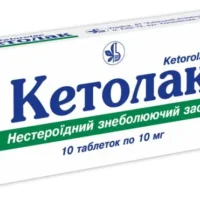Description
Indometacin Coated Enteric Tablets 25 mg. №30
Ingredients:
Each coated tablet contains 25 mg of Indometacin.
Mechanism of Action:
Indometacin, a nonsteroidal anti-inflammatory drug (NSAID), inhibits prostaglandin production by blocking cyclooxygenase enzyme, thereby alleviating inflammation, pain, and fever.
Pharmacological Properties:
Indometacin possesses analgesic, anti-inflammatory, and antipyretic properties by inhibiting prostaglandin synthesis, exerting effects on various tissues and organs.
Indications for Use:
Indometacin is indicated for pain, inflammation, and swelling in conditions like rheumatoid arthritis, osteoarthritis, ankylosing spondylitis, gout, and musculoskeletal disorders.
Contraindications:
Avoid Indometacin if there is hypersensitivity to Indometacin or other NSAIDs, peptic ulcers, gastrointestinal bleeding, severe heart failure, or renal impairment. Consult a healthcare professional before use.
Side Effects:
Common side effects include gastrointestinal disturbances, headache, dizziness, fluid retention, and skin reactions. Serious effects may involve gastrointestinal bleeding, renal dysfunction, and cardiovascular events.
Usage Instructions:
Take Indometacin orally with water. The typical dose is 25 mg two to three times daily, preferably with meals. Do not crush or chew to avoid gastric irritation.
Benefits Compared to Analogues:
Indometacin provides potent anti-inflammatory and analgesic effects, with rapid onset and efficacy in acute pain episodes compared to other NSAIDs.
Suitable Patient Groups:
Generally safe for adults, including the elderly, for short-term relief. Caution in pediatric patients, pregnant women, and those with gastrointestinal or cardiovascular conditions.
Storage Conditions and Shelf Life:
Store in a cool, dry place away from moisture and sunlight. Keep out of children’s reach. Check expiration date and do not use expired tablets.
Packaging Description:
Supplied in blister packs with 30 enteric-coated tablets. Packaging should be intact and sealed, with dosage strength imprinted on each tablet for identification.
Scientific Evidence:
Indometacin’s efficacy in managing pain and inflammation is supported by clinical studies, showing reduction in joint swelling, improved mobility, and enhanced quality of life in patients with inflammatory conditions.





